Archive for the ‘Merz’ Category
Tuesday, August 6th, 2019
“Anger is a very limiting emotion. There’s not much you can do with it. There’s no hope in it.”
— Wendell Berry
There was a time when the arts may have held the capacity to alter the world around us. From time to time, music probably has. Perhaps the dramatic arts, too. The oral and written arts of language certainly have, and they remain highly consequential, but the notion that those engaged in artistic “visual statements” can affect society is an illusion. The early 20th-century avant-garde believed they could, and maybe they did to some limited extent, while the attention of a less distracted elite was seized. At any rate, this innovative class took what they had absorbed, rejected much of it, and cultivated the vocabulary of the modern art forms which influence the bulk of what artists do today. And almost all of what we do now has very little if any catalytic effect on evolving civilization — especially if it was overtly intended to do just that. But make no mistake about it, “message art” has been, is, and can be a significant catharsis for creative individuals. Rest assured that it will reinforce solidarity among people of like mind. It can also be relied upon to irritate many of the others.
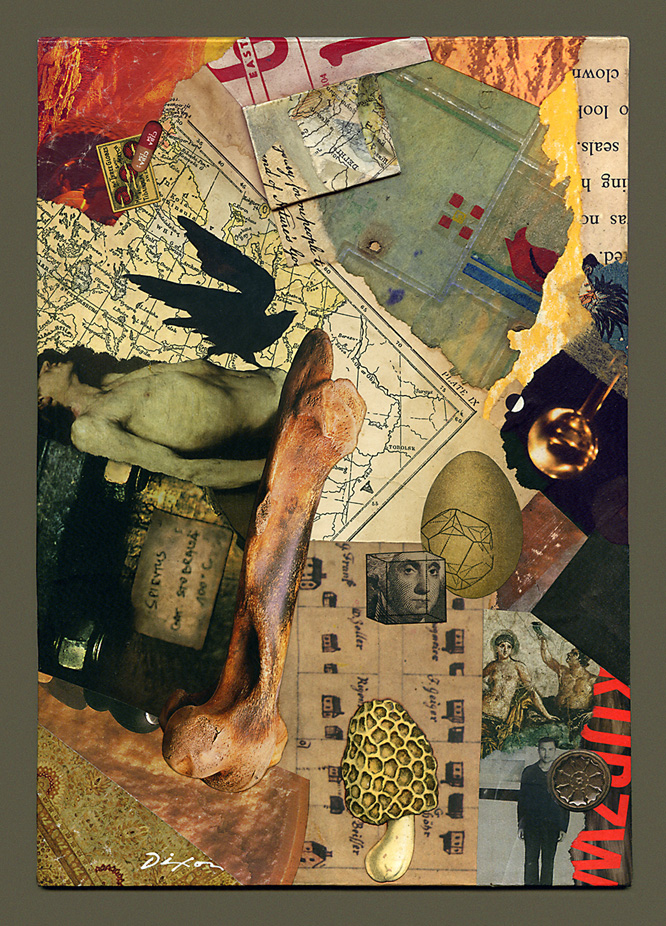
Taboo Faction
collage catharsis by J A Dixon
8.125 x 11.5 inches
Purchase this artwork.
Posted in 1) Available!, Catharsis, Constructivism, Criticism, Cubism, Dada, Influences, J A Dixon, Merz, Music, Surrealism, W Berry | No Comments »
Monday, January 7th, 2019
“The most interesting paradox of creativity: in order to be habitually creative, you have to know how to prepare to be creative, but good planning alone won’t make your efforts successful; it’s only after you let go of your plans that you can breathe life into your efforts.”
— Twyla Tharp
“You take what you know, you take things you are comfortable with, and you throw them into a situation of new things, of things you are uncomfortable with, and, all of a sudden, new connections happen. And then your goal as a creative must be: of having the skill to carry it home without breaking it.”
— Christoph Niemann
Brandon Long is making a name for himself as an assemblage artist in Kentucky. He manages to juggle this with being a blogger, an active volunteer, and his full-time role as an outstanding family man. On top of that, he holds down a challenging, “multi-hat” position at our local Community Arts Center. This past autumn, his request to exhibit at their annual winter invitational arrived like clockwork: show the public an entirely new work, no jury evaluation, just put something at the leading edge of your creativity on display. There can’t be a single regional artist receiving that call who doesn’t value it as a rare opportunity.
I’d been thinking for much of last year about another immersion into larger works — not always a comfort zone for a self-described “miniaturist.” Add to that several months of recovery from a knee injury which limited my standing time. I reckoned I was overdue for a boost in the scale of my studio work. When it came time to plunge in, I realized it also was the perfect chance to reassess my current methodology. I wanted to explore a way of developing an abstract composition that was different for me. Could I combine and balance both a rational and non-rational process? By now, I had more than a decent foundation in each, but had never fused them in as mindful a manner as I considered possible. 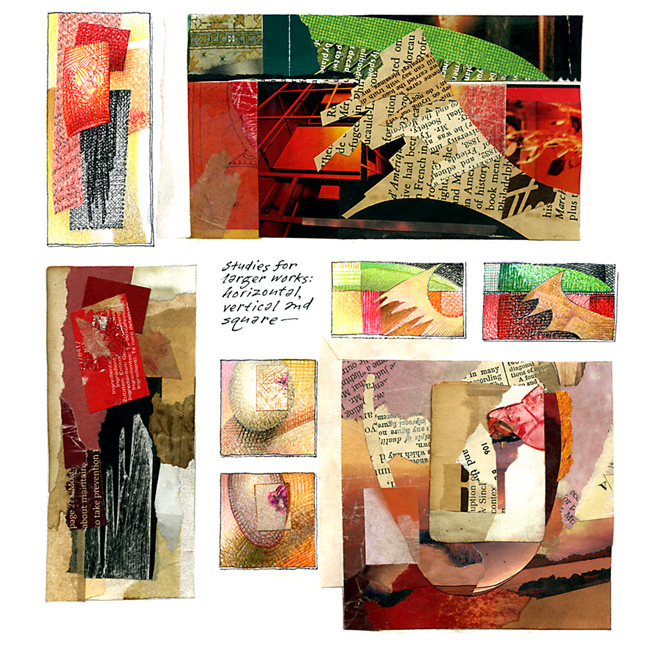 It didn’t turn out to be complicated at all, and yet it was a new approach for me, after more than twelve years as a dedicated collage practitioner.
It didn’t turn out to be complicated at all, and yet it was a new approach for me, after more than twelve years as a dedicated collage practitioner.
Deciding to make three works at horizontal, vertical, and square proportions, I began with thumbnail concepts in my journal, moving from tiny doodles, to color sketches, and from there to rough collage miniatures. The activity was deliberate, but I tried to hold it at an intuitive level. After that, I moved to the typical task of preparing the “stretchers,” although nothing would be fabricated from scratch. I found a nearly fifty-year-old, unpainted canvas in remarkable shape. I stretched Pellon® fabric over a discarded picture frame. I paid almost nothing at a flea market for a castoff “student-esque” painting that needed some reinforcement, its canvas re-stretched, plus lots of primer. 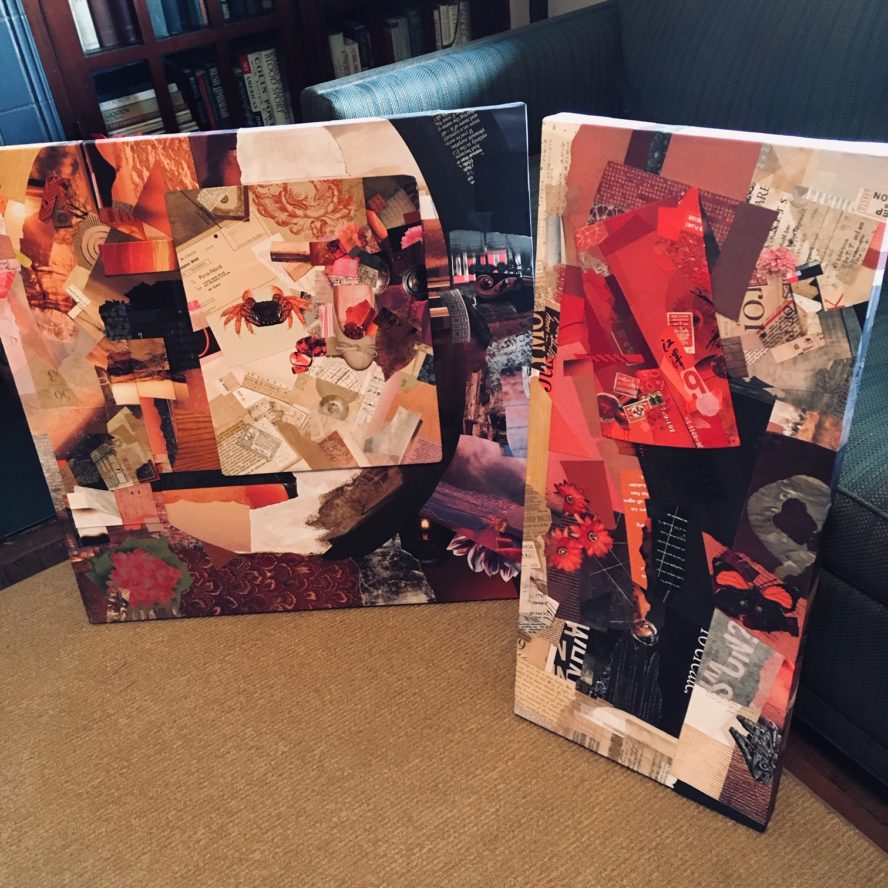 After sorting categories of available paper scrap into flat boxes, I was ready to explode into routine sessions of Merz assembly, with an occasional reference back to my preliminary ideas. When probing to the heart of intuition like this, a collage artist stumbles upon strange dynamics. For instance, there are times when you’ll ignore an emotion that says “this doesn’t belong,” only to press on and discover that it totally “works” with the next layering of ingredients. Perhaps this is more characteristic of collage maximalism than collage minimalism. I would accept that fully, but it’s fascinating to remain aware of the “joust” between whether to trust feelings or trust pure impulse, and to discern the difference. Finally, there came a point when I introduced the hard evaluation of a visual critique, before finishing with intentional refinements — and even that final stage allows for spontaneity.
After sorting categories of available paper scrap into flat boxes, I was ready to explode into routine sessions of Merz assembly, with an occasional reference back to my preliminary ideas. When probing to the heart of intuition like this, a collage artist stumbles upon strange dynamics. For instance, there are times when you’ll ignore an emotion that says “this doesn’t belong,” only to press on and discover that it totally “works” with the next layering of ingredients. Perhaps this is more characteristic of collage maximalism than collage minimalism. I would accept that fully, but it’s fascinating to remain aware of the “joust” between whether to trust feelings or trust pure impulse, and to discern the difference. Finally, there came a point when I introduced the hard evaluation of a visual critique, before finishing with intentional refinements — and even that final stage allows for spontaneity.
It’s not always easy to know when a piece is done, and maybe it never really is. Eventually, an artist has to claim victory and sign the damn thing. I ended up delivering two works to the Center for the “New Year New Art” show, and let Brandon pick one that fit best. It was the square, the one I called Harmonic Squall.
Please give these four details your scrutiny. Let me know what you think, and, if you find yourself in the area, attend our opening reception this Friday evening. It’s always the first good party after New Year’s Eve!
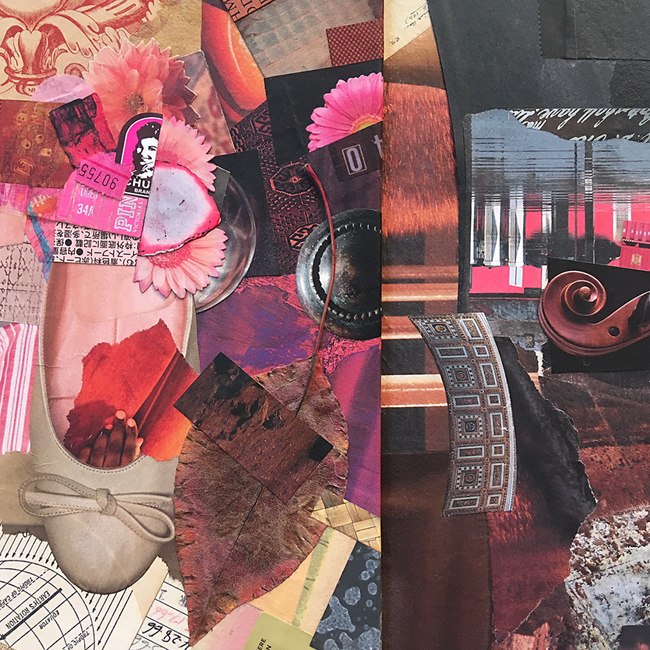

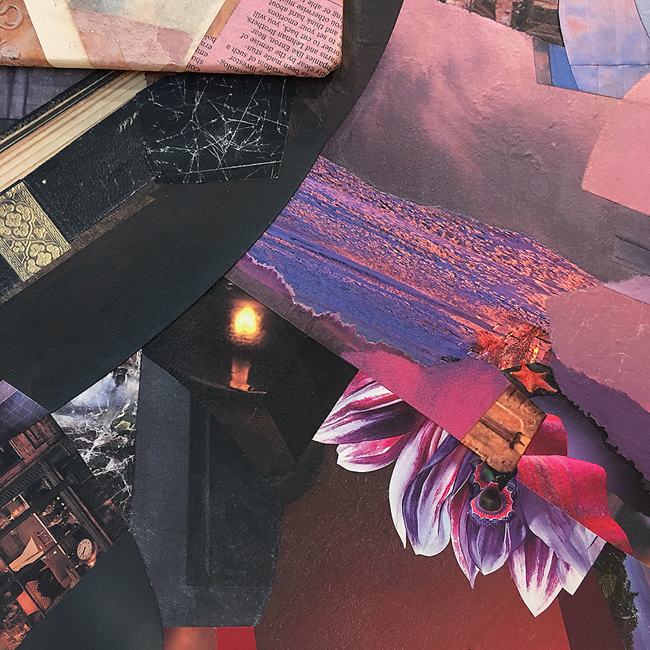

four
details
from
Harmonic
Squall
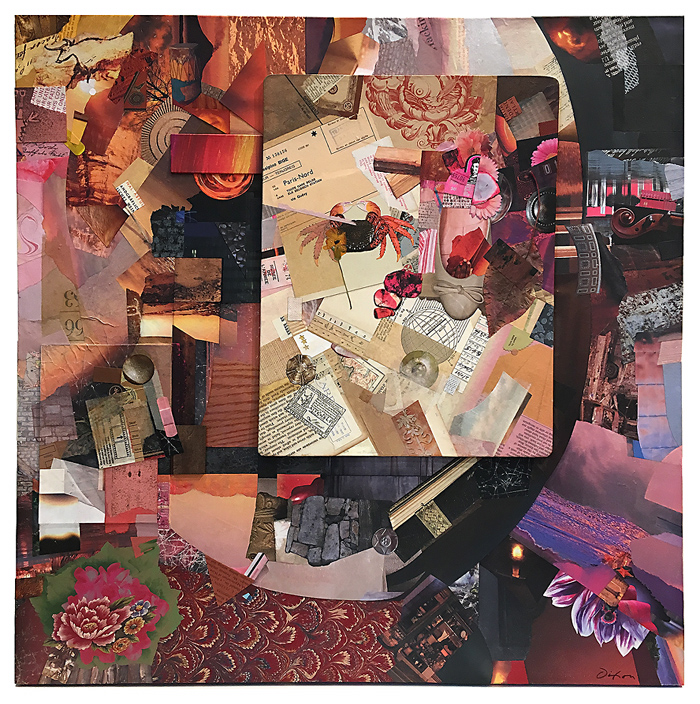
Harmonic Squall
collage on recycled canvas by J A Dixon
26 x 26 inches
available for purchase
Purchase this artwork.
Posted in 1) Available!, Abstraction, Assemblage, B Long, C Niemann, Collage, Details, Embedded Miniatures, Events, Exhibitions, Ingredients, J A Dixon, Larger Works, Maximalism/Minimalism, Merz, Methodology, New Year New Art, T Tharp, Technique | 2 Comments »
Tuesday, September 18th, 2018
Sharing a major announcement in the world of collage and assemblage: The Ontological Museum has undertaken an entire makeover of its online archives. Let all doff their hats to Cecil Touchon!
Beware — connoisseurs of the collage medium can be swept into this magnificent black hole of imagery. Just a few outstanding examples are featured below.
Fellow collage artists, it is up to us to grow and preserve this extraordinary collection. Become a subscribing member!
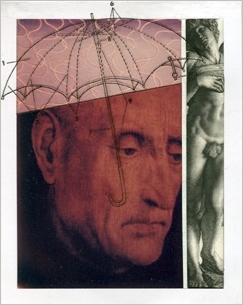
The Sun Always Shines on TV
collage artwork by Cory Peeke, 2010
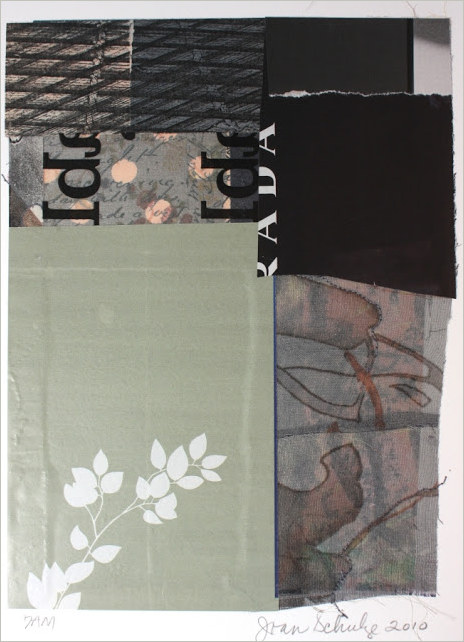
7 am
collage artwork by Joan Schulze, 2010
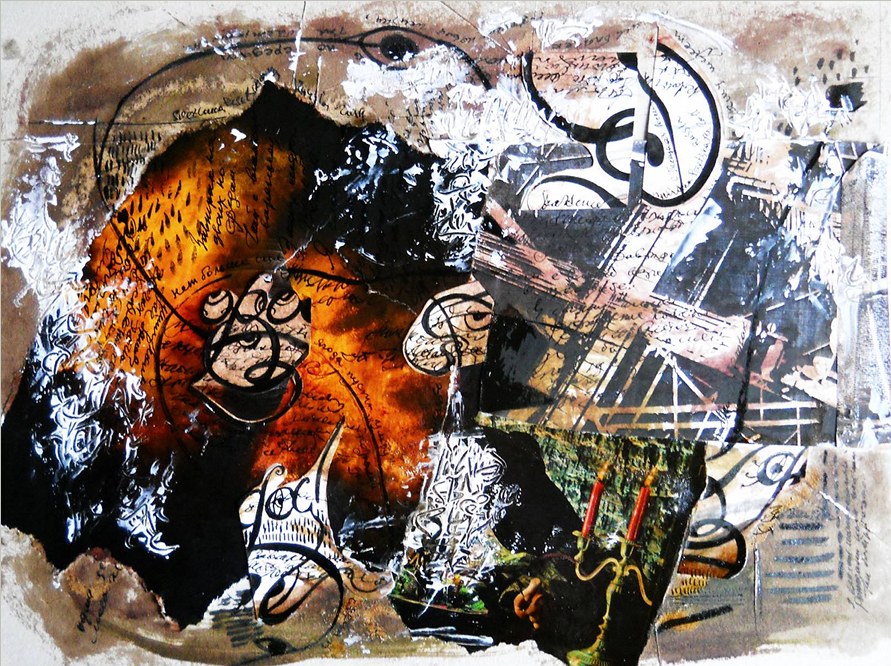
Ritual 2
mixed-media collage by Svetlana Pesetskaya, 2011
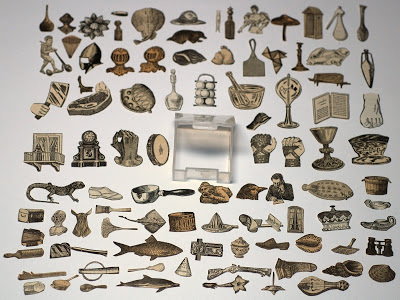
Case #10
small things by Hope Kroll for Fluxcase Micro Museum, 2011
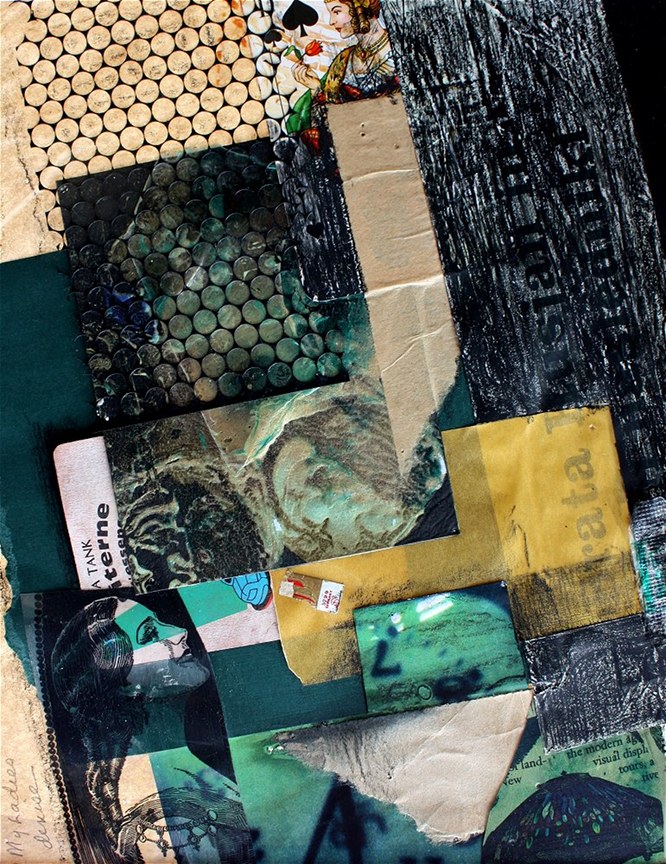
(title unknown)
mixed-media collage on paper by Denise Pitchon, 2012
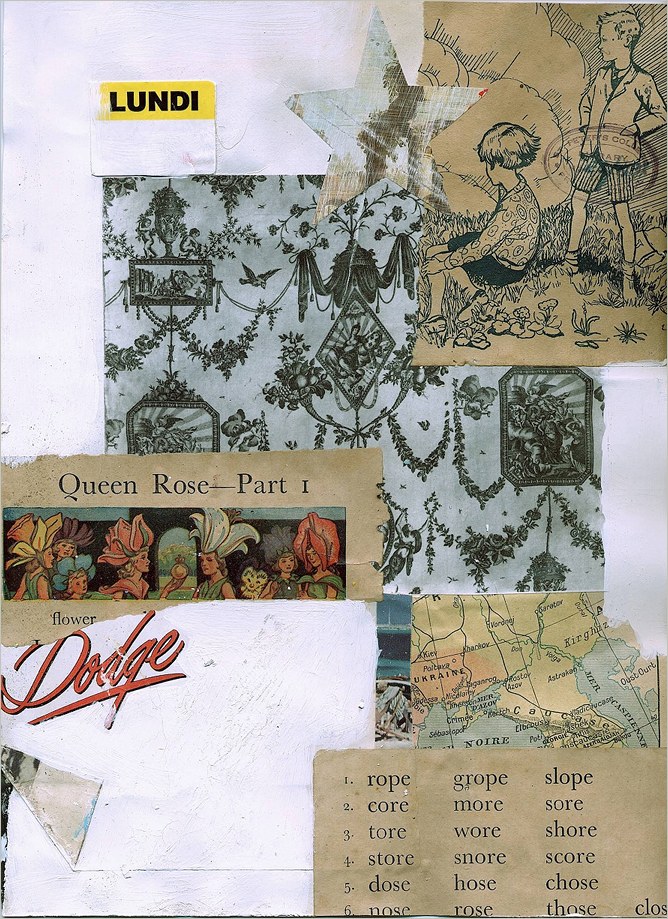
Queen Rose Score
collage on paper by Matthew Rose, 2012
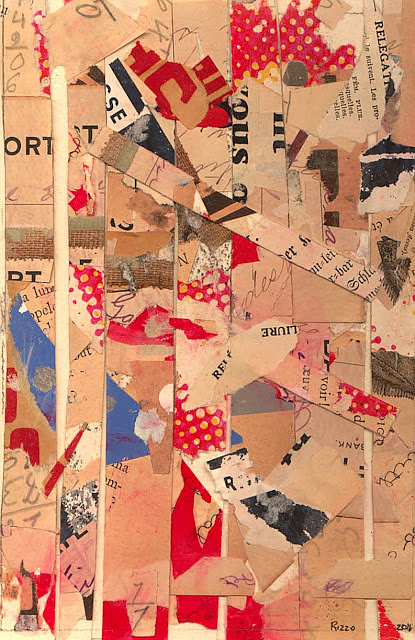
(title unknown)
collage for Dada Centennial by Bob Rizzo, 2016
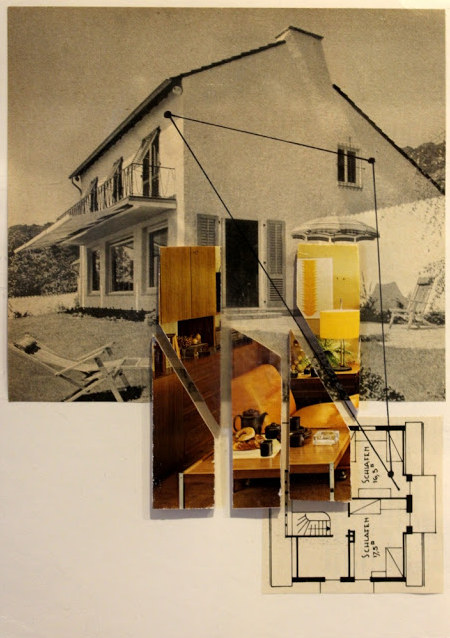
Homage to Merzbau
collage artwork by Sabine Remy, 2016
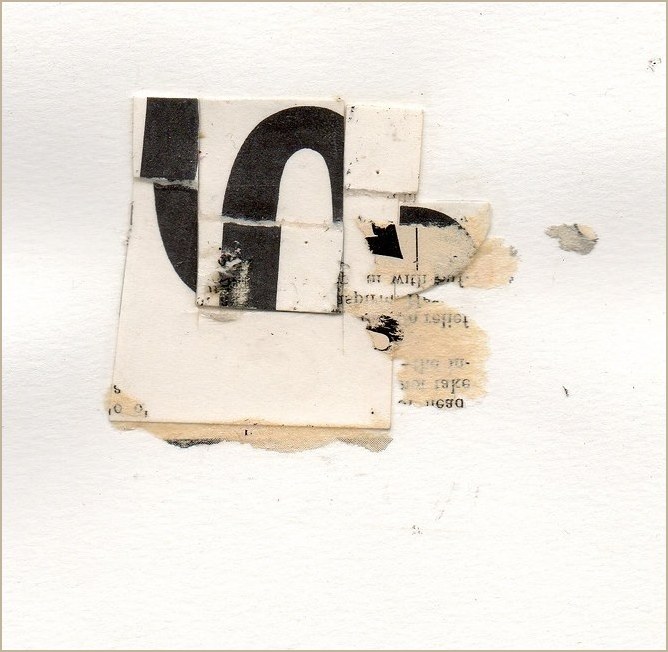
(title unknown)
asemic collage on paper by Jim White, 2018
(images courtesy of The Ontological Museum)
Posted in B Rizzo, C Peeke, C Touchon, Collage, D Pitchon, Dada, Fluxus, H Kroll, J Schulze, J White, Links, M Rose, Merz, Museums, S Pesetskaya, S Remy | 1 Comment »
Tuesday, August 21st, 2018
“We do not analyze works of art because we want to imitate them or because we distrust them.”
— Paul Klee
The other day the world learned about an unpublished Ernest Hemingway short story. If there had not been a Mark Twain first, would literature know Hemingway’s writings at all? Could there have been an Isaac Asimov, Stan Lee, or Gene Wolfe without a Verne or Burroughs? The J.K. Rowling body of work without an Austen or Tolkien? 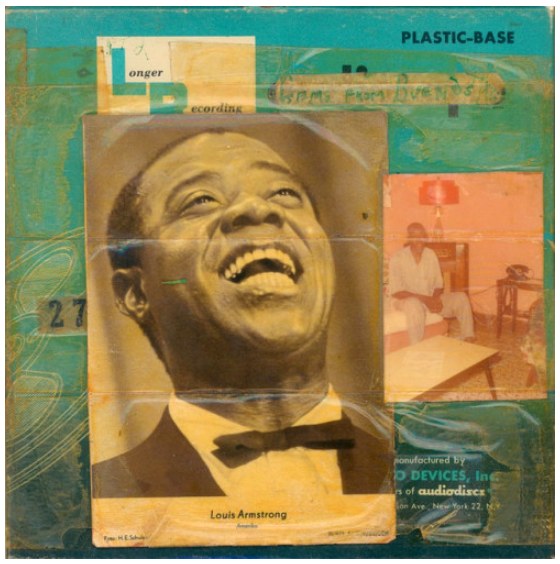 Similarly, all of today’s rock music can be linked to direct influences — to bands such as Ramones, Led Zeppelin or the Beatles, which, of course, had their own precursors. Would jazz exist in its current form without the innovations of Armstrong and all those who inspired him? Imagine a contemporary musician saying, “I really haven’t paid attention to any music that was recorded before I started to play.” And yet, not infrequently, collage artists will boast that they have little use for art history (all the breakthroughs of bygone creators who dug the swimming pools in which they now frolic).
Similarly, all of today’s rock music can be linked to direct influences — to bands such as Ramones, Led Zeppelin or the Beatles, which, of course, had their own precursors. Would jazz exist in its current form without the innovations of Armstrong and all those who inspired him? Imagine a contemporary musician saying, “I really haven’t paid attention to any music that was recorded before I started to play.” And yet, not infrequently, collage artists will boast that they have little use for art history (all the breakthroughs of bygone creators who dug the swimming pools in which they now frolic).
It is argued that modern artists were the first to decide that visual art would be about art, rather than subject matter. Nonsense. Art has always been about art, because it always has been structured on prior foundations. The idea that any artist can burst on the scene as an original is absurd. Nobody who comes out of early childhood with any level of awareness has not built an inventory of perceptions — countless images from the culture around them. Each of these individual influences involved creative activity based on another bank of stimuli, and so forth, back to the first proto-human who picked up a piece of charcoal to make interesting marks on a stone (and was probably knocked on the head by another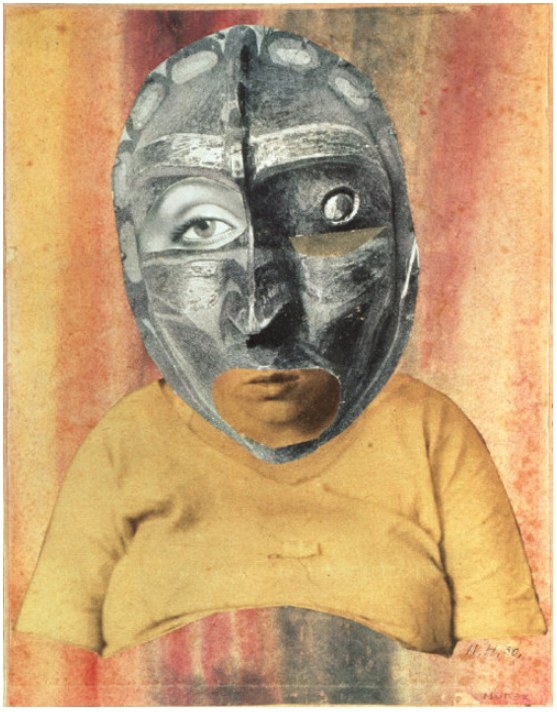
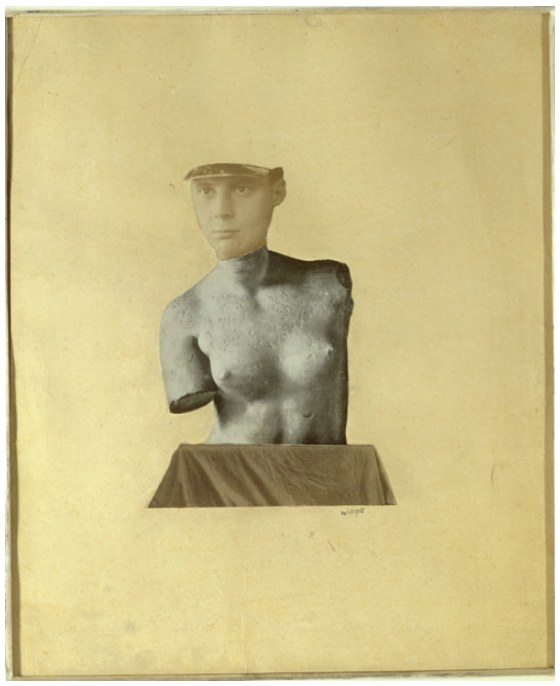 who judged the action as irrelevant to group survival).
who judged the action as irrelevant to group survival).
Perhaps I have belabored my point. Perhaps it is a point that anyone who reads this would not need emphasized in the first place. Isn’t it obvious to us that no art form is more about all these churning influences from untold visual decision makers — painters, printers, illustrators, photographers, designers — than the medium of collage itself? So, let us all continue to study the collage artworks of the explorers who came before us, to trace the direct lineage of their concepts and techniques, to recognize that valuable inheritance in the work of our peers, as well as in the composition taking shape on the surface before us, and then, fully informed, to push confidently into the second century of collage.
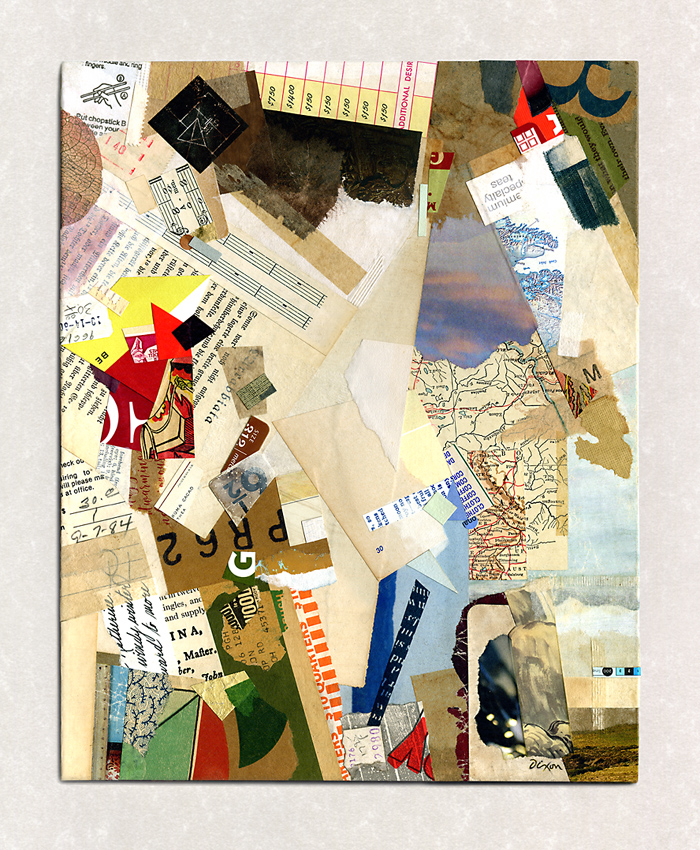
Tranquil Ode (to Merz)
collage homage by J A Dixon
9.5 x 11.875 inches
Purchase this artwork.
Posted in Abstraction, Applied Arts, Collage, Criticism, Cubism, Dada, Fluxus, Graphic Design, H Höch, Homage, Illustration, Influences, J A Dixon, J T Baargeld, K Schwitters, Literature, M Twain, Merz, Music, P Klee, Priorities, Surrealism | No Comments »
Saturday, March 31st, 2018
“You can’t really make ideas, create ideas. You know, all ideas are the same. They just wander by. If your house has mice, you never know when they’re going to show up, or how, or in which room. and great ideas are the same. They’re like mice. Just a mouse. A mouse in the house. And you step on its tail and you go, ‘Hold it, buddy.’”
— Jerry Seinfeld
Ideas will suggest ingredients, but, as often as not, ingredients will spark ideas. Actually, I prefer the latter. In discussing the groundbreaking Merz pictures of Schwitters, curator Isabel Schulz asserts that his materials “surrender their original function … but not all semantic meaning.” Those meanings can generate layers of additional meaning when ingredients combine in synergy. Before long, if the exterminator is not on site, the house is happily full of mice.
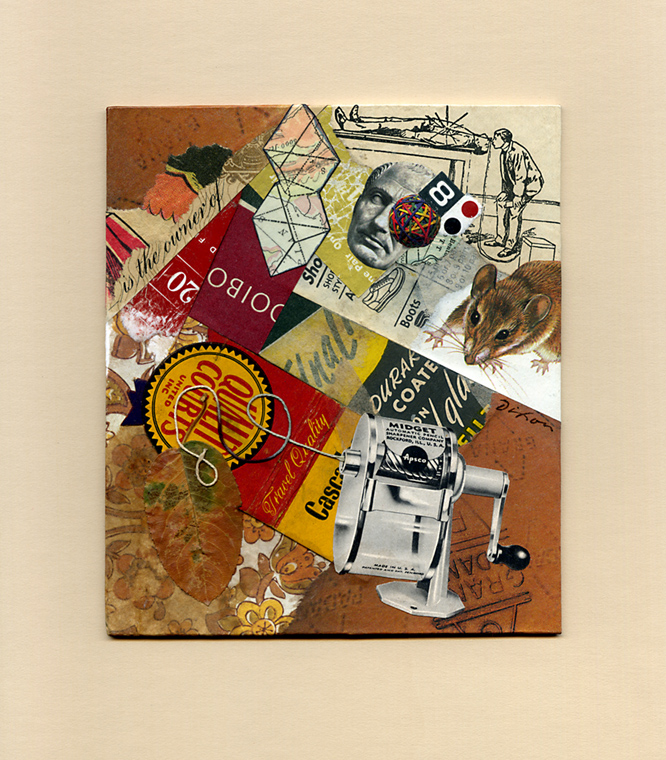
Mouse in the House
collage miniature by J A Dixon
4.75 x 5.5 inches
Purchase this artwork.
Posted in 1) Available!, Collage, Ingredients, J A Dixon, K Schwitters, Merz | No Comments »
Saturday, March 17th, 2018
“Schwitters began making collages in 1918 and produced them in large numbers for the remainder of his career. In 1919 he began using the term ‘Merz’ (which originated from the German word ‘Kommerz’, meaning ‘commerce’) to describe his principle of assembling found materials.”
— Louise Hughes
Das Kirschbild — a fitting followup for the previous entry on abstraction.
And for those of us who never tire of learning new things about the incomparable Master of Merz:
• from the Armitt Museum Collection in the Lake District
• from the Tate Britain
• from the Guggenheim
• from the Sprengel Museum Hannover

Merzbild 32 A. Das Kirschbild
Kurt Schwitters, 1921
The Museum of Modern Art, New York
Posted in Dada, Influences, K Schwitters, Links, Merz, Museums | No Comments »
Saturday, March 10th, 2018
“In the ’20s, dadaist Kurt Schwitters collected bits of detritus such as cigar bands and bus tickets and used them in collages. They were shocking then but with the passage of time have taken on the aura of classics: vibrantly colored and harmonious arrangements of abstract forms and only incidentally assemblages of junk.”
— John Ashbery
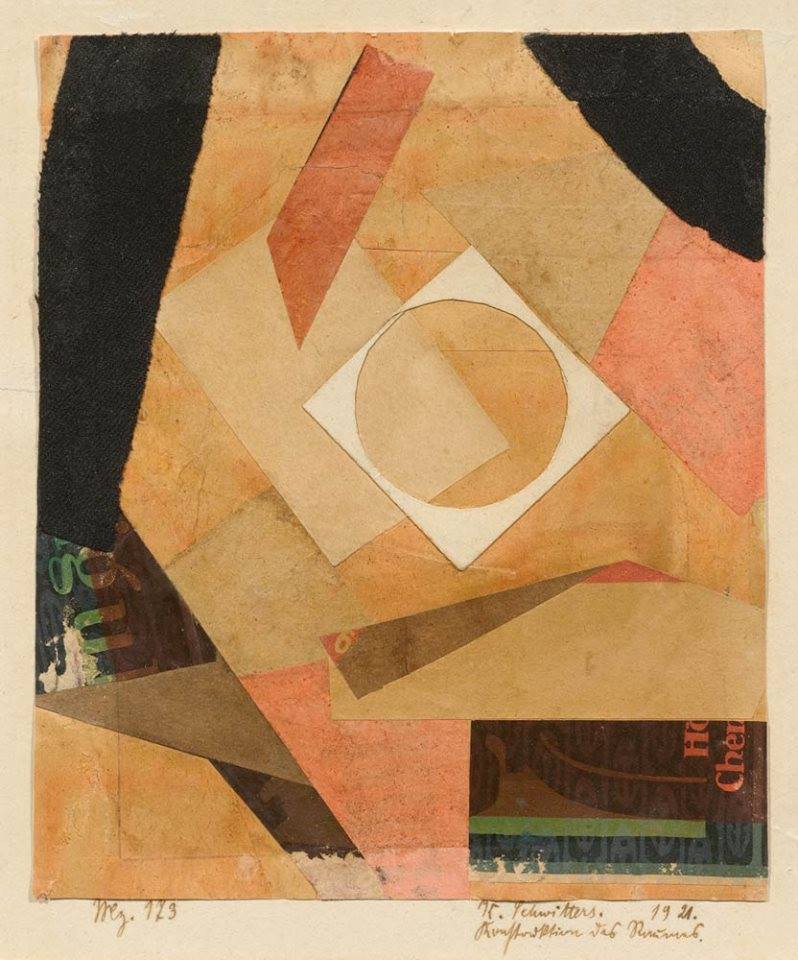
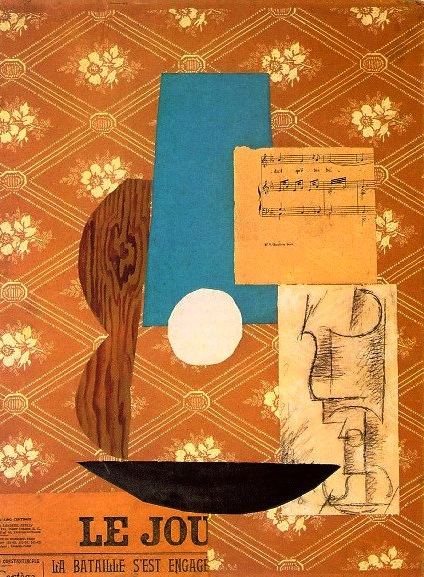 About a hundred years ago, a handful of Europeans had set out to invent what we now know as the medium of collage. Nearly all of them were painters. From the beginning, collage was rooted in modern art concepts that were emerging at the same time — the fundamentals of abstraction. Thus, the evolution of abstraction and collage in the 20th century are entwined, and remain so in a burst of contemporary activity in this post-centennial period. Next year will mark a full century of Merz. Artists working in collage abstraction carry the “creative code” of Kurt Schwitters and his seminal innovations.
About a hundred years ago, a handful of Europeans had set out to invent what we now know as the medium of collage. Nearly all of them were painters. From the beginning, collage was rooted in modern art concepts that were emerging at the same time — the fundamentals of abstraction. Thus, the evolution of abstraction and collage in the 20th century are entwined, and remain so in a burst of contemporary activity in this post-centennial period. Next year will mark a full century of Merz. Artists working in collage abstraction carry the “creative code” of Kurt Schwitters and his seminal innovations. 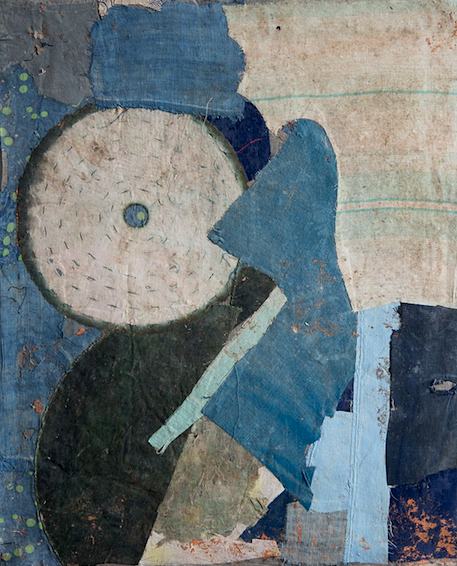 But, allow me to pause here and point out something that has become increasingly obvious: conventional art history was woefully male centered. Intentionally or not, the discipline would downplay or ignore many exceptional women artists, and that includes collage antecedents which were largely the domain of females, especially in the domestic or folk arts. For example, an interesting feature at moowon.com highlights the forgotten art of Chinese textile collage.
But, allow me to pause here and point out something that has become increasingly obvious: conventional art history was woefully male centered. Intentionally or not, the discipline would downplay or ignore many exceptional women artists, and that includes collage antecedents which were largely the domain of females, especially in the domestic or folk arts. For example, an interesting feature at moowon.com highlights the forgotten art of Chinese textile collage. 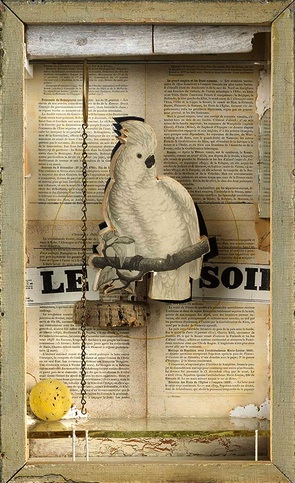 Picasso lifted visual ideas from tribal cultures. Cornell borrowed techniques tied directly to Victorian crafts. We understand that now. Modern art did not spring fully formed from the brow of Zeus like the armored goddess Athena. Fast forward to 2018. Many of the most accomplished and widely recognized collage artists of today are women. And the best part is that we know about them.
Picasso lifted visual ideas from tribal cultures. Cornell borrowed techniques tied directly to Victorian crafts. We understand that now. Modern art did not spring fully formed from the brow of Zeus like the armored goddess Athena. Fast forward to 2018. Many of the most accomplished and widely recognized collage artists of today are women. And the best part is that we know about them.
Melinda Tidwell is one of the dedicated abstractionists in collage that I enjoy following. She has a solid and very articulate designer “upstairs” guiding each decision, but her regard for the unexpected is a strong part of her intuition. Last summer, she published a two-part discussion of “order versus disorder” at her blogsite. It features abstractions by Lance Letscher and is well worth checking out.
Please indulge me as I share examples of collage abstraction from artists who continue to favorably capture my eye. Some of them range into mixed media in a way that remains very much collage. Others are strictly “painting with paper.”
Merz is alive and well in the 21st century, my friends.

(title unknown)
abstract collage by L Letscher
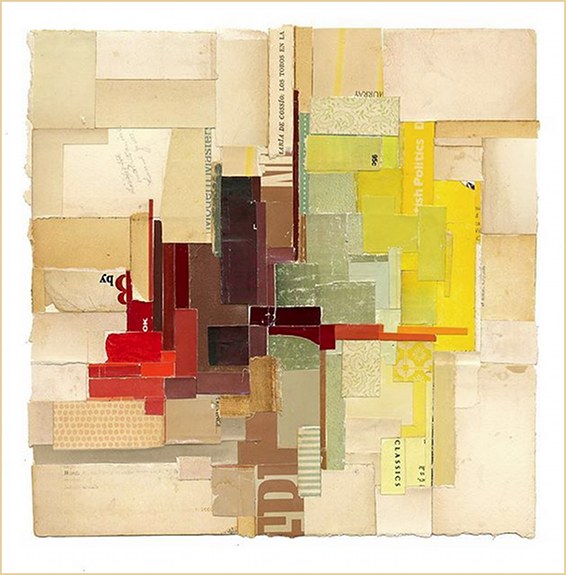
(title unknown)
abstract collage by M Tidwell
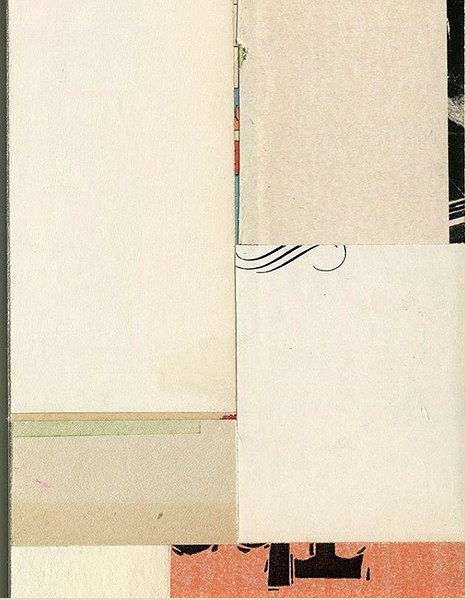
11zc18
abstract collage by Z Collins
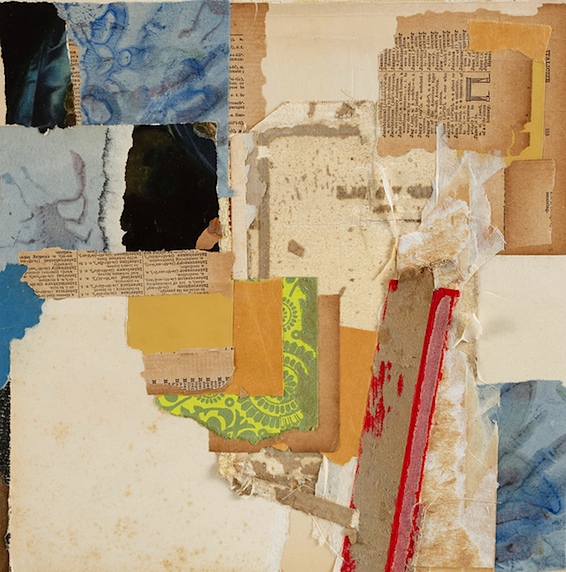
Elysburg IV
abstract collage by C Chapman
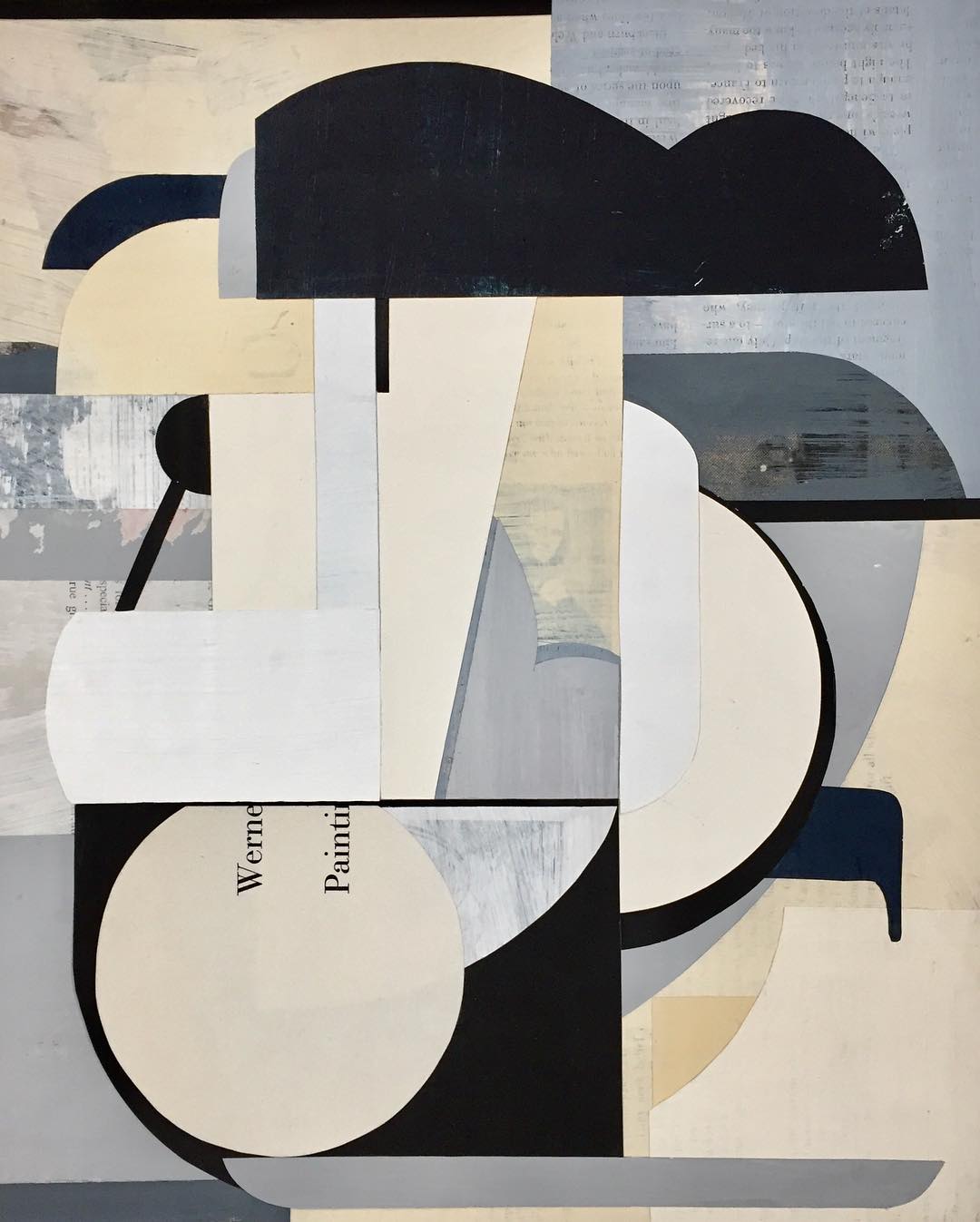
Ellington
abstract collage by D McKenna
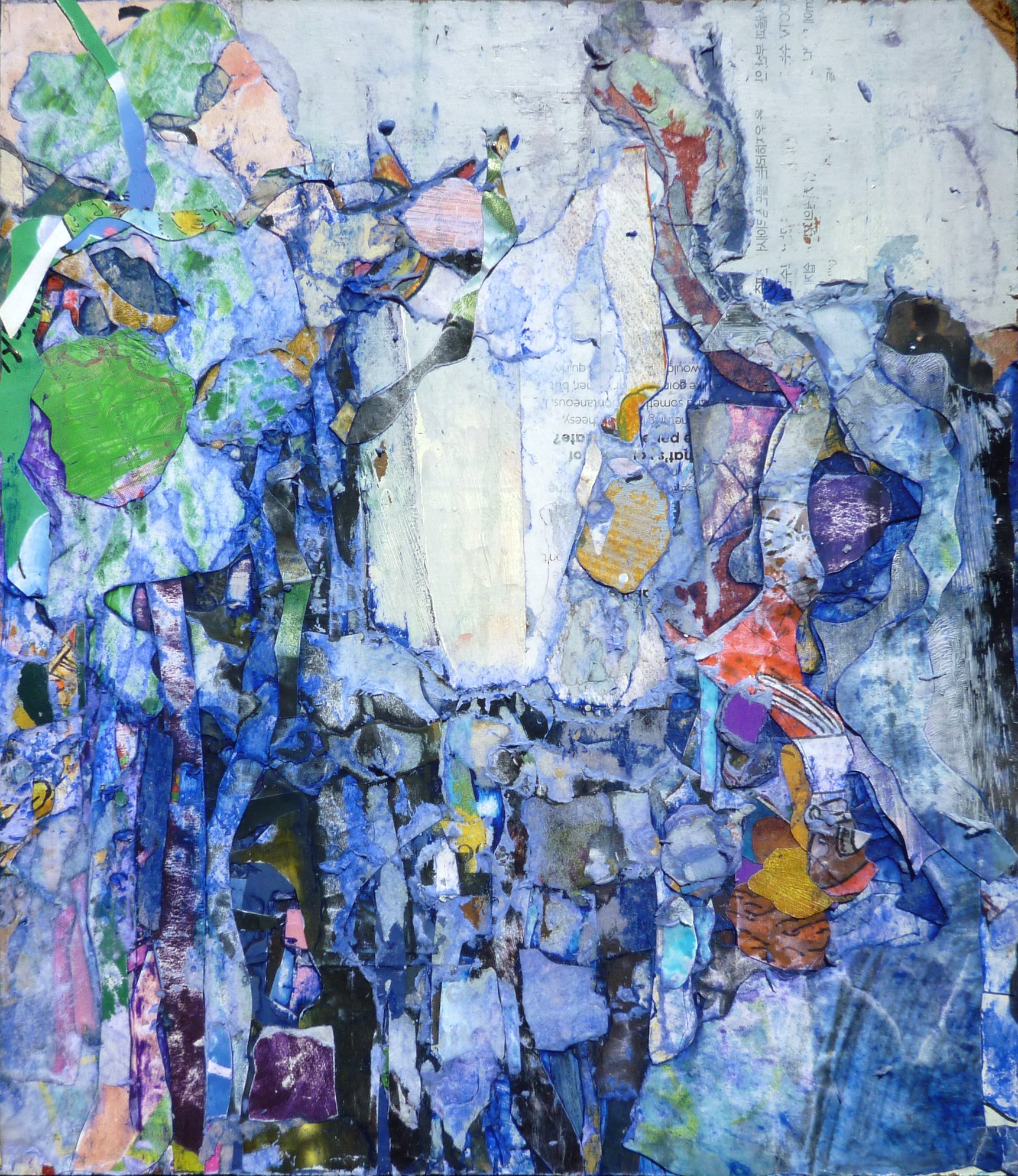
Osmosis 3
abstract collage by C Emeleus
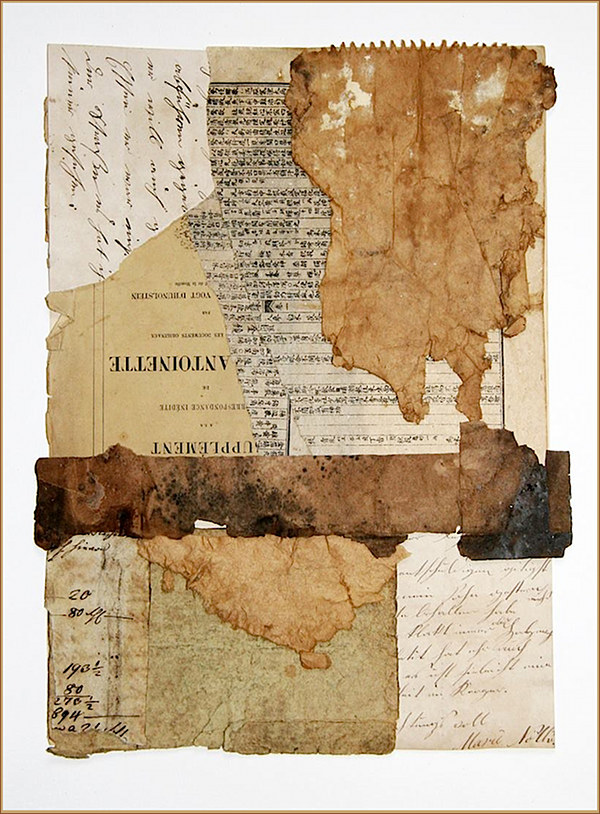
Antoinette
abstract collage by W Strempler
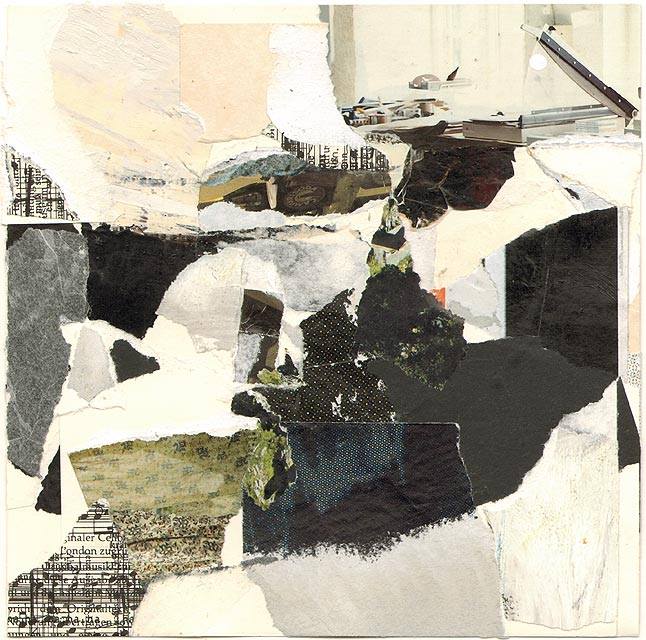
Music
abstract collage by S Kraft
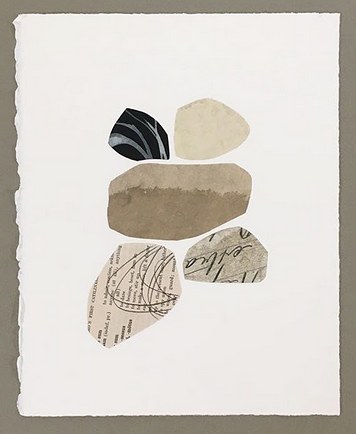
from her series, BALANCE
abstract collage by S A Herman
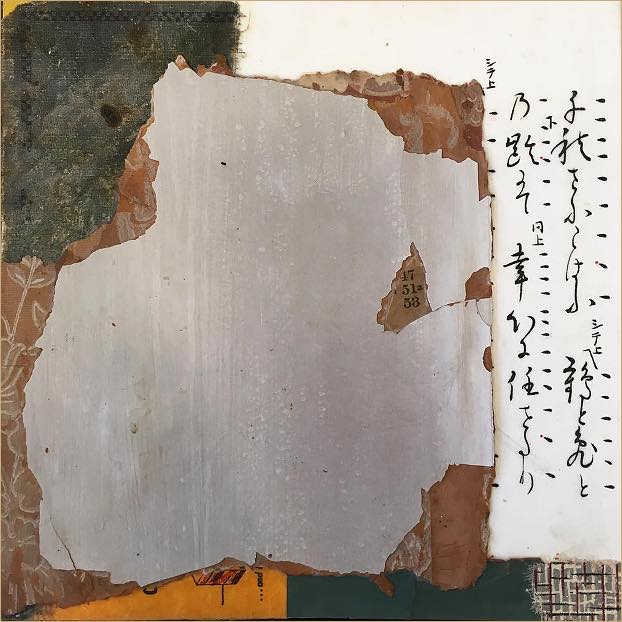
Day 18 of 40
abstract collage by C Neubauer
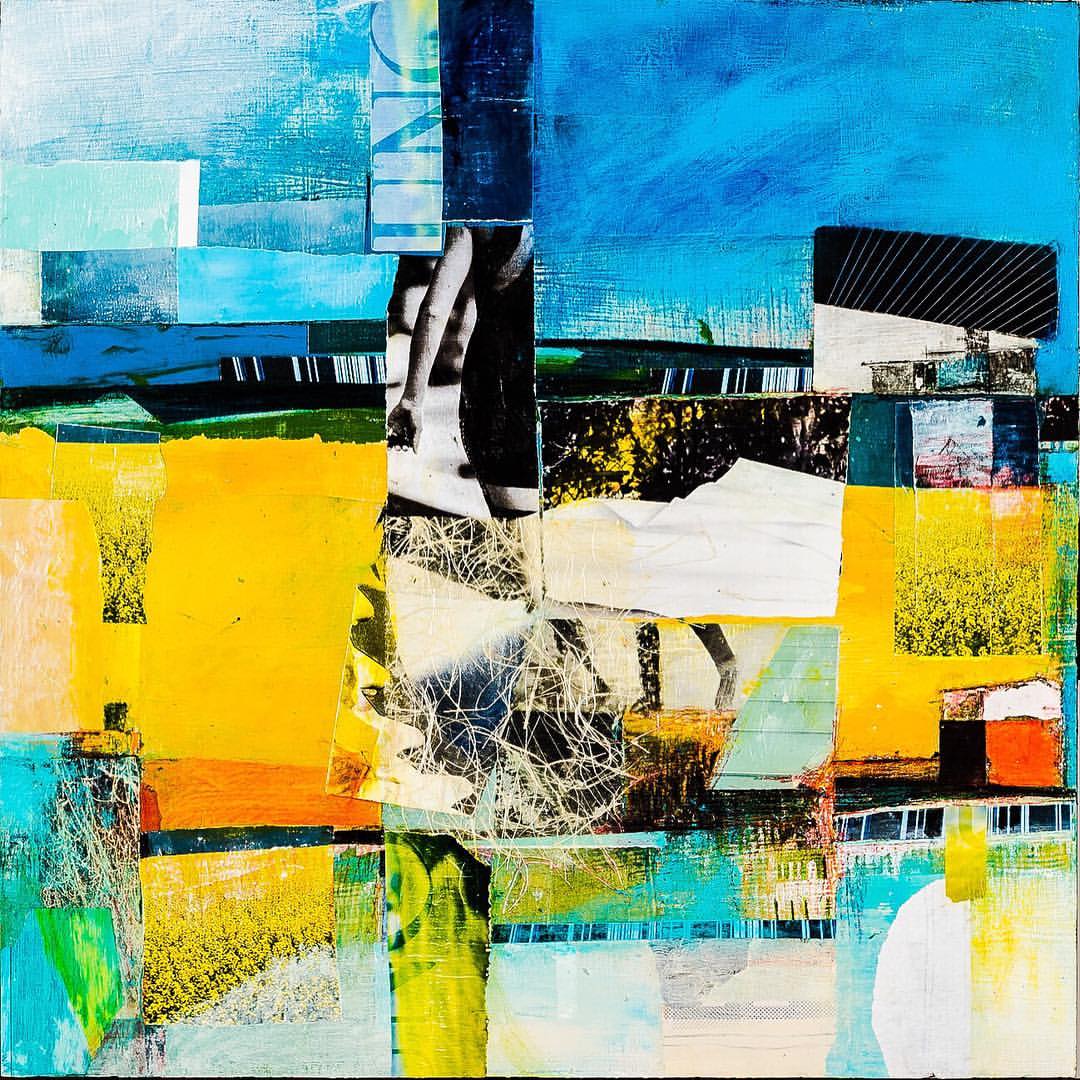
Red Cottage — from her series, SENSE OF PLACE
abstract collage by P A Turner
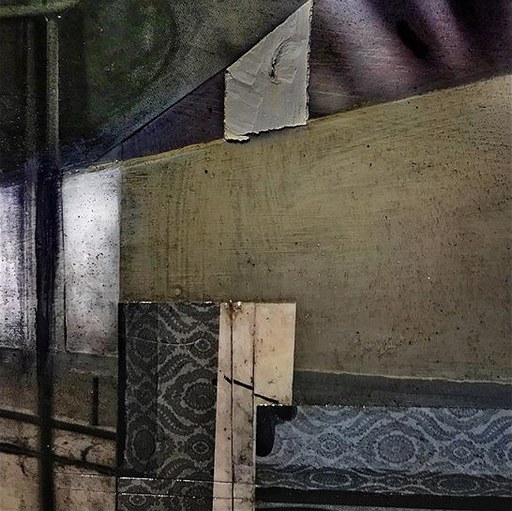
(title unknown)
abstract collage by J C Martin
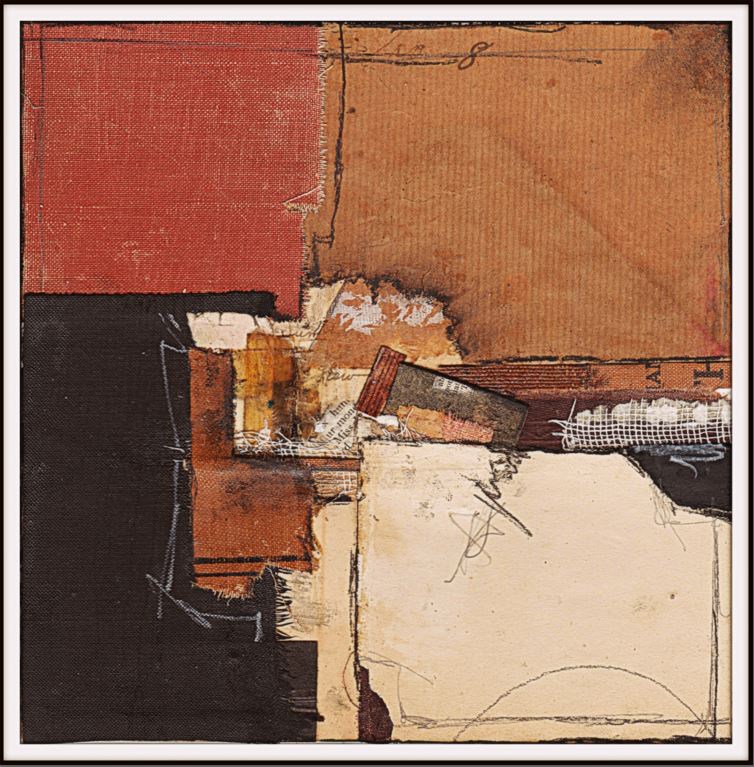
Reap
abstract collage by G Cooper
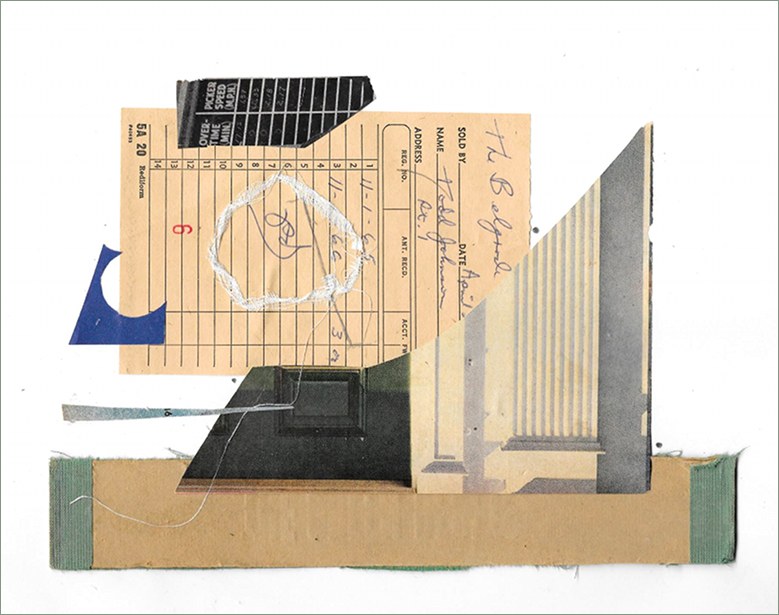
Cognitives and Conclusions
abstract collage by S Ringler
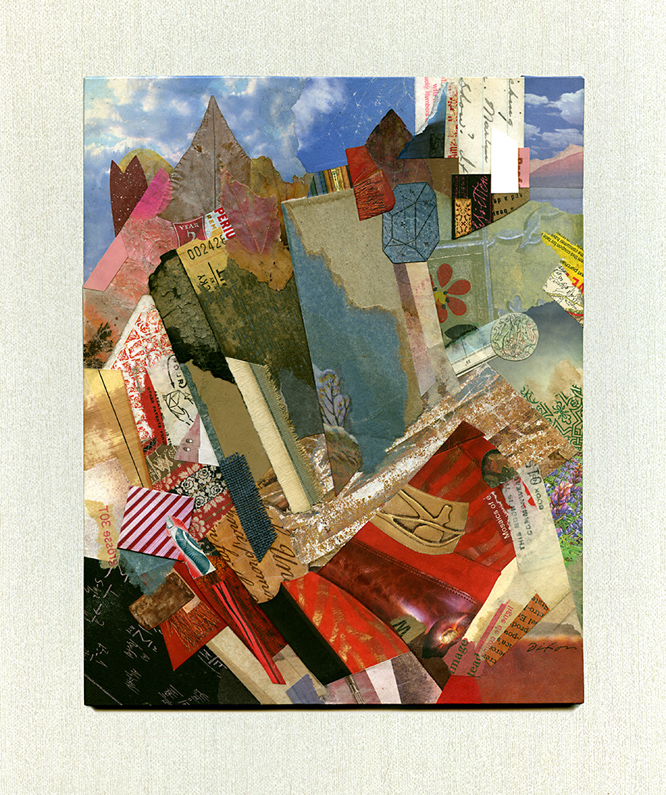
Dynamic Stability
abstract collage by J A Dixon
Purchase this artwork.
Posted in Abstraction, C Chapman, C Emeleus, C Neubauer, Collage, Cubism, D Ellington, D McKenna, Folk Art, G Cooper, Influences, J A Dixon, J C Martin, J Cornell, J Gris, K Schwitters, L Letscher, M Tidwell, Merz, P A Turner, P Picasso, S A Herman, S Kraft, S Ringler, W Strempler, Z Collins | No Comments »
Saturday, January 13th, 2018
“I have always tried to exploit the photograph. I use it like color, or as the poet uses the word.”
— Hannah Höch
It is always a temptation for a so-called blogger to dangle a “best of” or “top twenty” list to entice a visitor, and, of course, we see this tactic used almost on a daily basis in various fields of art and entertainment. How many of us have gone online and swallowed just such a colorful lure? On the most obvious level, the whole stimulus-response thing is a bit silly, but the potential to learn something new does exist, or to sharpen our own sense of quality, preference, and discernment. Each of us is free to have viewpoints, as long as we recognize them as personal opinions, and avoid casting them about as certitude. Isn’t there enough of that going on these days? (Yes, dear guest, that is merely my perspective.) 
What does this have to do with collage? Well, I just paid a visit to a page at AnotherMag.com (in response to the aforesaid bait), and I learned for the first time about three collage artists who were new to me, a working artist who purports to ruminate on “all things collage.” In this particular case, there may have been an explicit effort to achieve an overdue gender balance for a post intended to spotlight the Höch retrospective at the Whitechapel Gallery in London, but one could question the absence of Paolozzi, Rauschenberg, Johnson, Hamilton, or Kolář. To not include at least one of these men as a key figure in the history of collage brings no meaningful discredit on any of the artists, but only on the list. (And that, too, is just my opinion).
Nevertheless, I am not ashamed to accentuate the gaps in my collage literacy and to feature three noteworthy female artists: Eileen Agar, Nancy Spero, and Annegret Soltau. Examples of their work should have appeared here long before now.

Woman reading
by Eileen Agar, 1936
Museum of New Zealand

Protagonists
by Nancy Spero, 1989
disposition unknown

Grima – mit Katze
by Annegret Soltau, from her 1986-97 series
Vero Group Collection, Houston, Texas
Posted in A Soltau, Assemblage, Collage, Criticism, Dada, E Agar, E Paolozzi, Exhibitions, G Braque, H Höch, Influences, J Cornell, J Kolář, J Stezaker, J Treece, K Schwitters, Links, M Ray, Merz, N Spero, P Donley, R Hausmann, R Johnson, R Rauschenberg, Surrealism | No Comments »
Sunday, May 7th, 2017
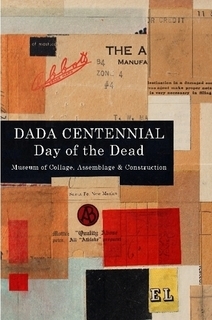 It is with high anticipation that I await my first look at the new publication which documents the Dada Centennial exhibition organized by the Ontological Museum. My sincere thanks to Cecil Touchon for including the essay that I wrote last year — On Kurt Schwitters and a Century of Dada — but, most of all, for volunteering so much of his time to this historic observation and to the ongoing administration of the institution he founded, now located in Santa Fe, New Mexico.
It is with high anticipation that I await my first look at the new publication which documents the Dada Centennial exhibition organized by the Ontological Museum. My sincere thanks to Cecil Touchon for including the essay that I wrote last year — On Kurt Schwitters and a Century of Dada — but, most of all, for volunteering so much of his time to this historic observation and to the ongoing administration of the institution he founded, now located in Santa Fe, New Mexico.
The exhibition at the archives of the International Museum of Collage, Assemblage and Construction opened on November 4, 2016 and lasted through January 31, 2017. A worldwide array of Dada-inspired artists sent artworks for the show that will be added to the permanent collection. They are all displayed in the full-color, 275-page catalog that is available for purchase. A “Merz Painting” by Peter Dowker is featured on the cover. In addition to my essay, the publication has an introduction by Touchon, another essay by Drager Meurtant, Birth of Merz by Schwitters, original verse by Dada artists, writings by Hugo Ball, three of my experimental miniatures, and collage art by some whose work I have spotlighted here at TCM, including Dowker, Hope Kroll, Zach Collins, Nikki Soppelsa, Erin Case, Joel Lambeth, Melinda Tidwell, Evan Clayton Horback, and Katrien De Blauwer.
When I experienced the milestone Schwitters exhibition at the Berkeley Museum of Art in 2011, I failed to bring home the forty-dollar catalog. When I got back to Kentucky, I discovered that the compendium was already worth $200. I do not know what long-term plan the Ontological Museum has for this publication, but it may not always be available. Go online, take advantage of the current discount, and buy it now.
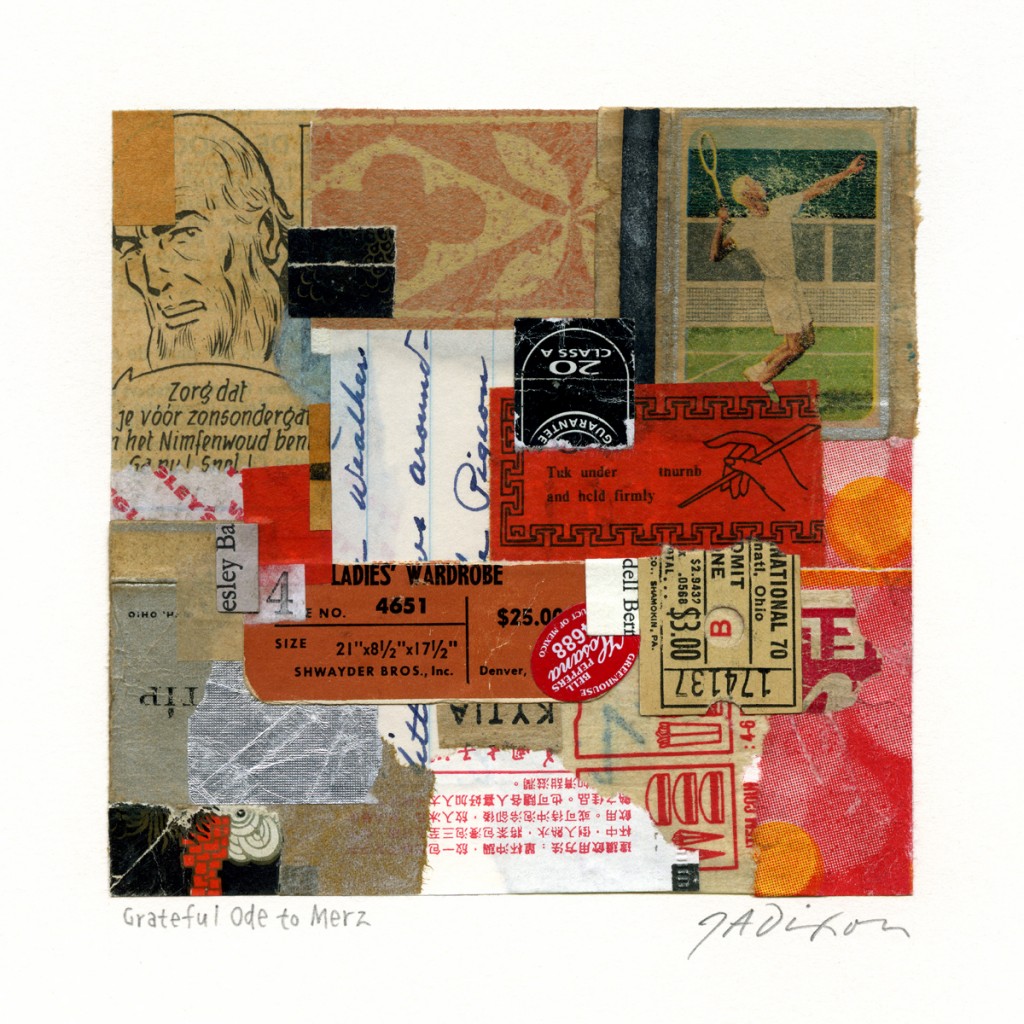
Grateful Ode to Merz
collage miniature on Bristol by J A Dixon
homage to Kurt Schwitters
collection of The Ontological Museum
Posted in C Touchon, Collage, Dada, E C Horback, E Case, Exhibitions, H Kroll, J A Dixon, J Lambeth, K De Blauwer, K Schwitters, M Tidwell, Merz, Museums, N Soppelsa, P Dowker, Publications, Z Collins | No Comments »
Sunday, March 5th, 2017
“If you’re coasting, you’re going downhill.”
— L W Pierson
Awhile ago, someone asked a question about the trajectory of collage: “What’s Next?” To ponder that, I remind myself that one thoughtful critique is worth more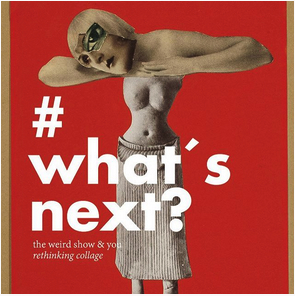 than a ton of casual “likes.” Those of us who love this practice need to push beyond the comfort of mutual praise and communicate honestly about the medium of collage (not about our political attitudes). Don’t expect the lords of social media to provide a thumbs-down button. That’s not the solution (even if they do). There needs to be the virtual equivalent of the intense coffee houses and night spots of a century ago, where artists were not shy about challenging the easy answers and safe solutions.
than a ton of casual “likes.” Those of us who love this practice need to push beyond the comfort of mutual praise and communicate honestly about the medium of collage (not about our political attitudes). Don’t expect the lords of social media to provide a thumbs-down button. That’s not the solution (even if they do). There needs to be the virtual equivalent of the intense coffee houses and night spots of a century ago, where artists were not shy about challenging the easy answers and safe solutions.
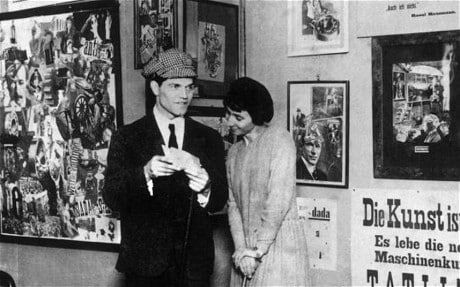 Höch, Hausmann, Schwitters, and their fellow collage “inventors” included found material contemporary with their times. There are many current practitioners who restrict themselves to “vintage” resources, and some of them avoid using anything younger than 50 years old. Whatever they choose to do is fine, but, in my opinion, 21st-century collage artists are challenged to explore the cast-off stuff of today for potential ingredients in a fresh “school of post-centennial collage” that “documents” our own culture, rather than confine themselves to curating the artifacts of our ancestors. Remember, when KS pasted down a tram ticket in place of a brushstroke, nearly a hundred years ago, he was clearly using something that he just acquired on the street. Let’s think about that when as ask ourselves, “What’s Next?”
Höch, Hausmann, Schwitters, and their fellow collage “inventors” included found material contemporary with their times. There are many current practitioners who restrict themselves to “vintage” resources, and some of them avoid using anything younger than 50 years old. Whatever they choose to do is fine, but, in my opinion, 21st-century collage artists are challenged to explore the cast-off stuff of today for potential ingredients in a fresh “school of post-centennial collage” that “documents” our own culture, rather than confine themselves to curating the artifacts of our ancestors. Remember, when KS pasted down a tram ticket in place of a brushstroke, nearly a hundred years ago, he was clearly using something that he just acquired on the street. Let’s think about that when as ask ourselves, “What’s Next?”
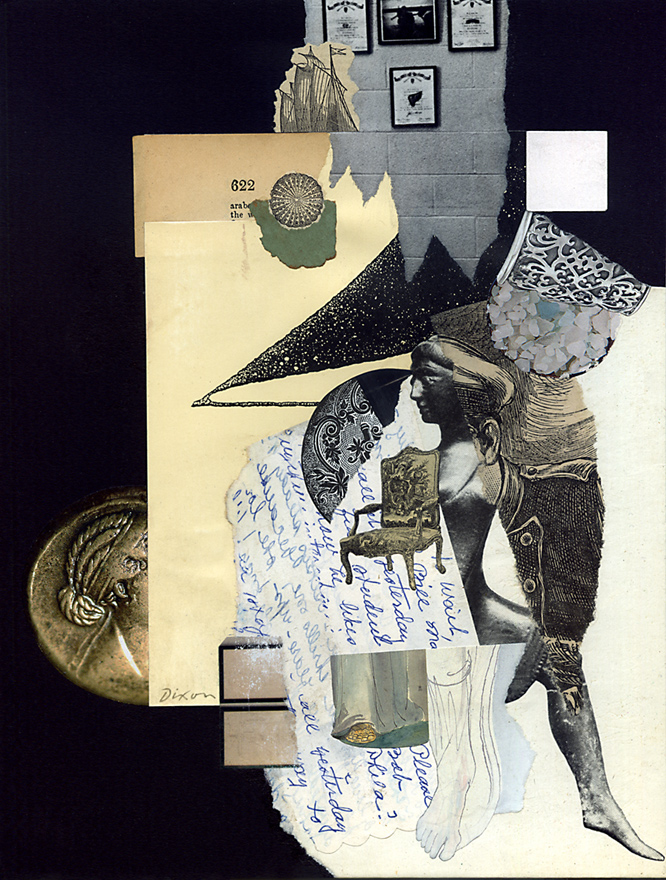
Tinged By Whispered Accounts
collage experiment in monochrome by J A Dixon
7.75 x 10.25 inches
Purchase this artwork.
Posted in Collage, Criticism, Dada, Experiments, H Höch, Ingredients, J A Dixon, K Schwitters, Merz, R Hausmann | No Comments »


















































